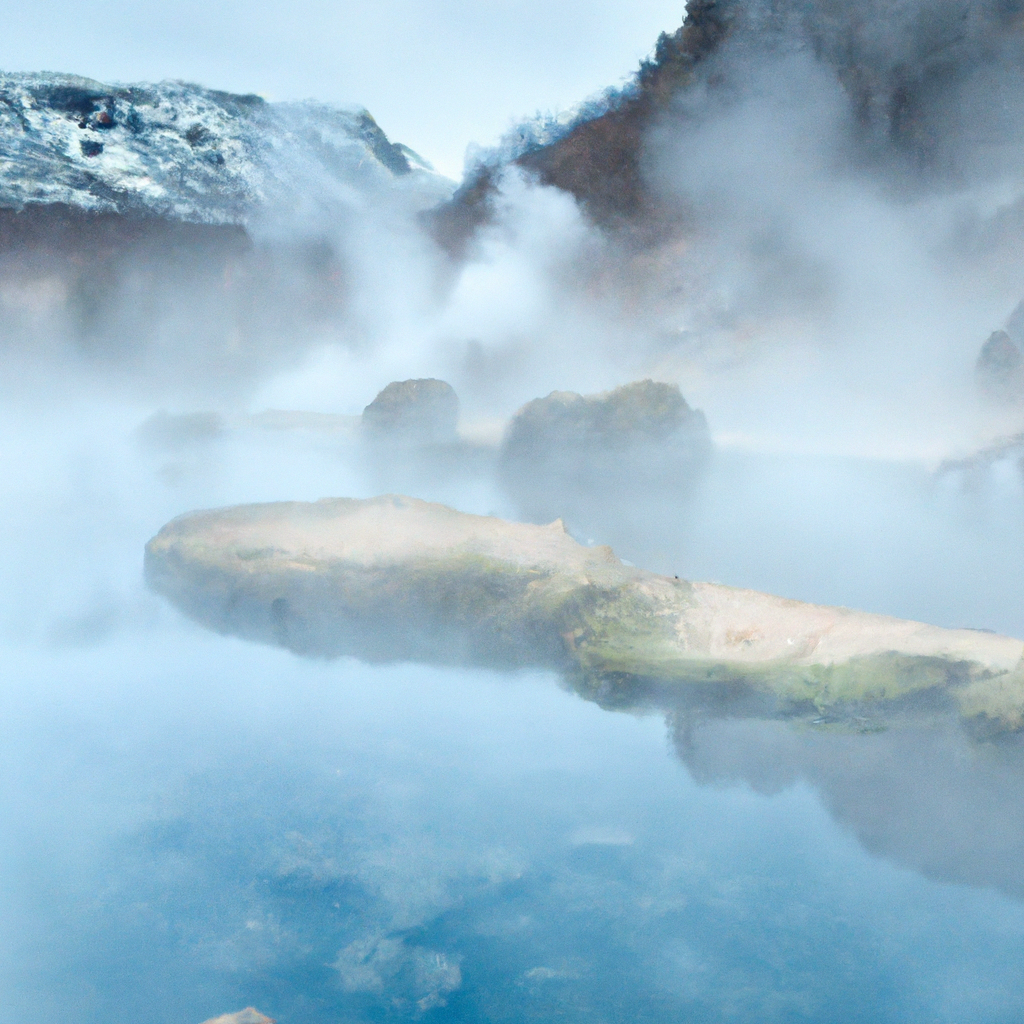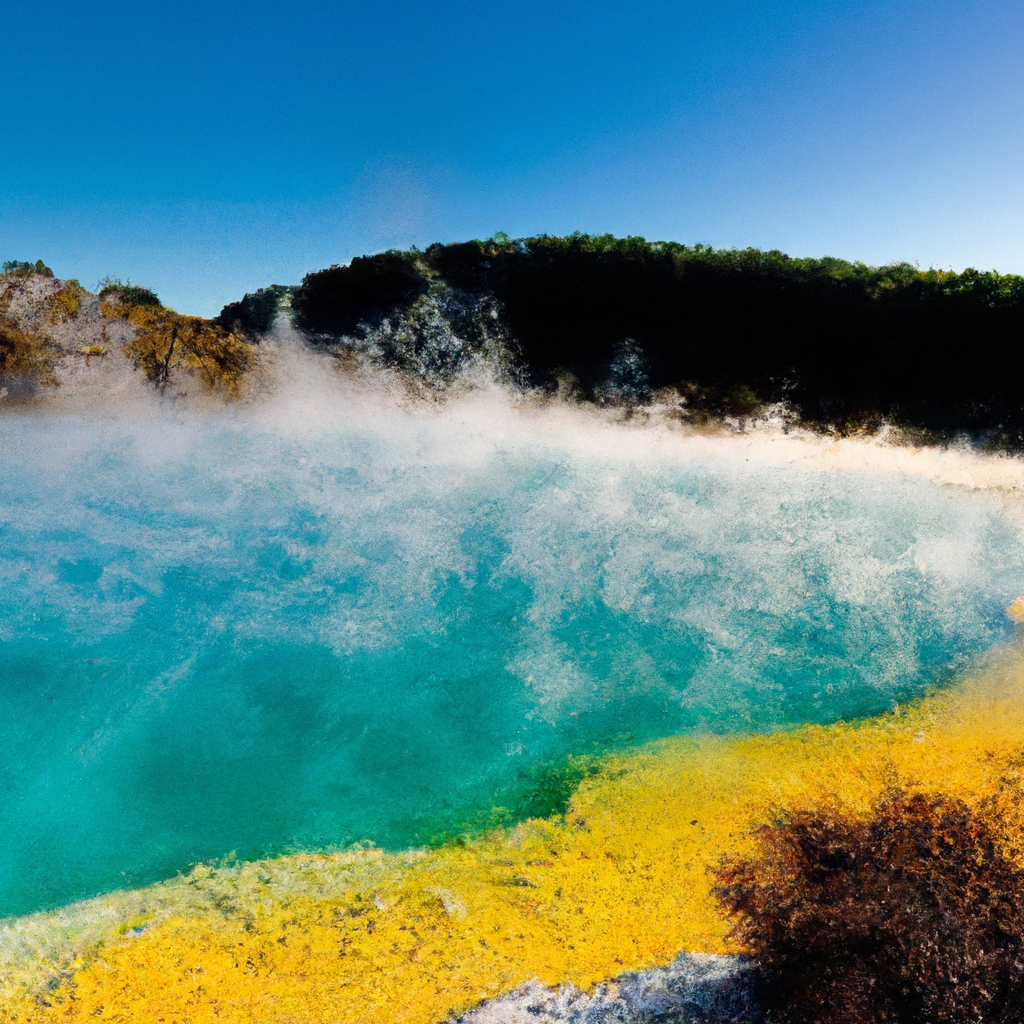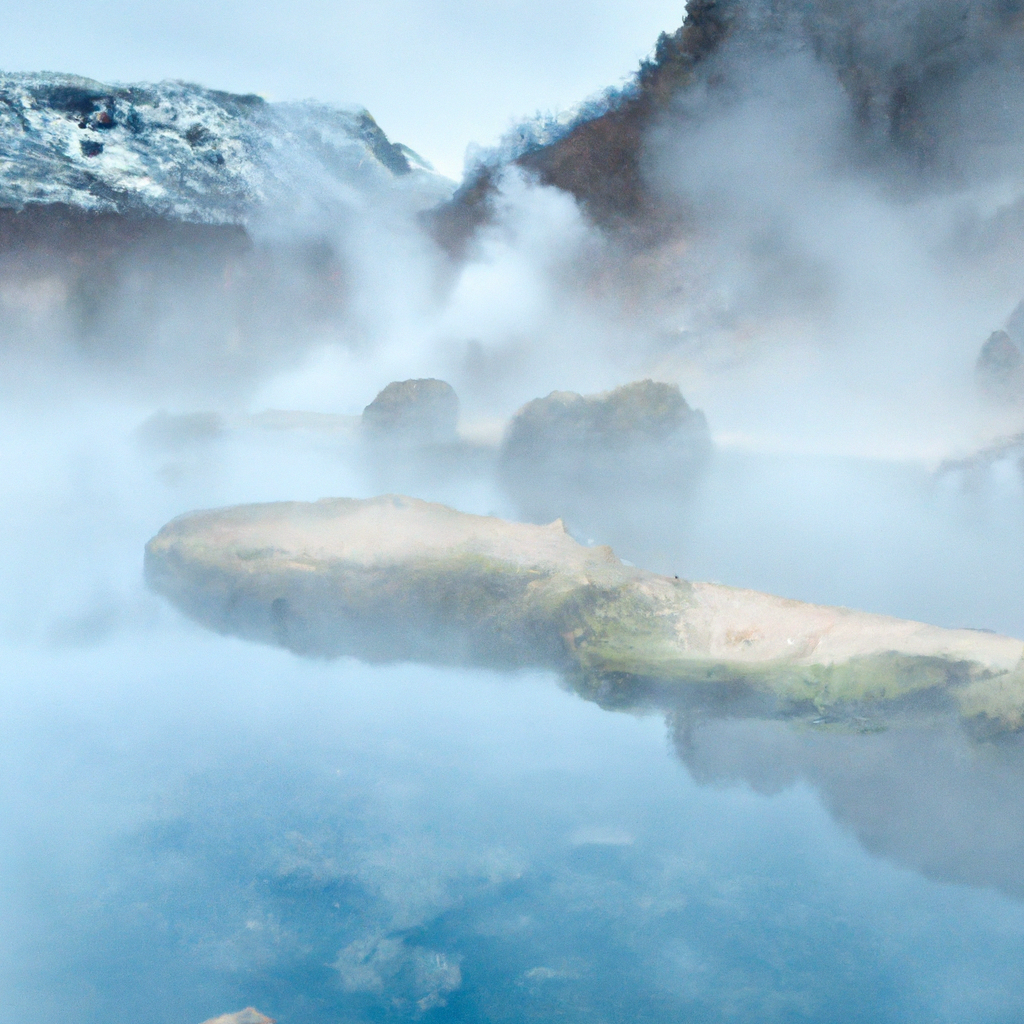Imagine immersing yourself in a natural hot spring, the water swirling around you, soothing your tired muscles and easing your stress. The healing power of hot springs has been recognized for centuries, believed to invigorate both the body and the soul. But besides its relaxation benefits, can these geothermal wonders also kill bacteria and viruses? This question becomes even more intriguing when considering hot springs in Alaska, where icy temperatures and remote locations create a unique environment. In this article, we̵7;ll explore the potential antibacterial and antiviral properties of hot springs, uncovering whether their healing touch extends to the microbial world. Get ready to dive into the fascinating world of hot springs and their hidden healing powers.

What are hot springs?
Hot springs are natural bodies of water that are heated geothermally by the Earth’s geothermal heat. These springs emit hot water or steam due to the accumulation of heat from rocks deep within the Earth’s crust. Hot springs can be found in various parts of the world, often in areas with volcanic activity or tectonic plate boundaries. They have long been appreciated for their beauty, relaxation, and potential health benefits.
Definition of hot springs
A hot spring is defined as a natural spring that has water temperatures above the average human body temperature, typically around 98.6°F (37°C). The temperature of hot springs can vary significantly, ranging from mildly warm to scalding hot. In some cases, the water may even reach boiling temperatures. These variations in temperature depend on factors such as the depth of the water source and the geological conditions present in the area.
Formation of hot springs
Hot springs are formed through a combination of geological processes. One common mechanism involves the heating of groundwater by geothermal energy generated by the Earth’s internal heat. As rainwater and other sources of water infiltrate the ground, they seep into fissures and porous rocks, where they encounter hot rocks heated by magma or hot fluids circulating deep underground. The heated water then rises back to the surface, creating hot springs. In volcanic regions, hot springs can also form through the interaction of volcanic heat and groundwater.
Health benefits of hot springs
Hot springs have been associated with various health benefits for centuries. While these claims may not be universally backed by scientific evidence, many people have reported positive effects on their well-being after soaking in hot spring water. Some of the potential health benefits include:
Relaxation and stress relief
Soaking in hot springs can provide a sense of relaxation and help relieve mental and physical stress. The warmth of the water and the serene surroundings can create a soothing environment, promoting a sense of calm and tranquility. This can be beneficial for individuals seeking relaxation and revitalization.
Improved circulation and blood flow
The heat from hot springs is believed to dilate blood vessels and improve circulation. This can potentially enhance the delivery of oxygen and nutrients to various parts of the body, promoting overall cardiovascular health. Improved blood flow may also help in the removal of metabolic waste products from tissues, leading to a potential detoxifying effect.
Pain relief and inflammation reduction
The heat and mineral content of hot springs have been associated with pain relief and reduction of inflammation. Soaking in warm water can help relax muscles, alleviate muscle tension, and potentially reduce discomfort associated with conditions such as arthritis, fibromyalgia, and muscular injuries. The mineral-rich water may also have anti-inflammatory properties, further aiding in pain management.
Skin health benefits
Hot springs are known for their mineral content, which often includes elements like silica, sulfur, calcium, and magnesium. These minerals can have various benefits for the skin. Soaking in hot springs may help cleanse the skin, improve its texture, and promote collagen production. Some individuals have reported improvements in certain skin conditions such as eczema, psoriasis, and acne after regular hot spring bathing.
The presence of bacteria and viruses in hot springs
While hot springs have many potential health benefits, it is essential to recognize that they can also harbor various microorganisms, including bacteria and viruses. The warm and mineral-rich environment of hot springs provides favorable conditions for microbial growth. However, it is important to note that not all bacteria and viruses present in hot springs are harmful or pathogenic.
Bacterial content
Hot springs can contain various types of bacteria, including thermophiles and extremophiles. These microorganisms are adapted to thrive in high-temperature environments. While some bacteria found in hot springs can be harmless or even beneficial, others have the potential to cause infections or diseases if they enter the body. Therefore, caution should be exercised to minimize the risk of infection.
Viral content
Viruses can also be present in hot springs, although their numbers are generally lower compared to bacteria. The presence of viruses in hot springs can vary depending on several factors, including the source of the water and human activities in the area. It is worth noting that not all viruses are pathogenic, and the risk of contracting a viral infection from hot spring water is relatively low. However, certain viruses can survive in hot spring environments, and proper precautions should be taken to minimize any potential risks.
Types of bacteria and viruses commonly found in hot springs
The specific types of bacteria and viruses found in hot springs can vary depending on location and other environmental factors. Some bacteria commonly found in hot springs include species of Thermus, Geobacillus, and Deinococcus. As for viruses, those from the family Herpesviridae and certain types of enteric viruses have been detected in hot springs. These microorganisms have their own unique properties, and further research is necessary to fully understand their potential impact on human health.
Can hot springs kill bacteria and viruses?
The high temperatures of hot springs have led to the belief that they possess sterilizing properties and can kill bacteria and viruses. While hot water does have some antimicrobial effects, it is important to understand the limitations of this phenomenon.
Temperature and its effect on microorganisms
High temperatures can indeed kill many microorganisms. Heat denatures proteins and damages cellular structures, leading to microbial death. However, certain bacteria and viruses have developed specific mechanisms to withstand extreme temperatures, including the ability to form protective structures such as spores or protein coats. This thermal resistance can vary greatly among different microorganisms.
Thermal resistance of bacteria and viruses
Not all bacteria and viruses are equally susceptible to high temperatures. Some thermophilic bacteria and heat-resistant viruses have evolved mechanisms to survive and thrive in hot environments. Therefore, while hot springs can eliminate many microorganisms, there are still species that can withstand the heat. It is essential to understand that hot spring water may not be completely sterile and could potentially contain pathogenic microorganisms.
The role of minerals and pH levels
The mineral content and pH levels of hot spring water can have an impact on the survival and growth of bacteria and viruses. Certain minerals, such as sulfur, have antimicrobial properties and can contribute to reducing microbial populations. Additionally, the pH of the water can influence the growth of different microorganisms. Some bacteria and viruses may thrive in alkaline conditions, while others prefer acidic environments. The composition of the hot spring water, including its mineral content and pH levels, can play a role in determining the survival of microorganisms.

Is soaking in hot springs safe?
Soaking in hot springs can be a safe and enjoyable experience for most individuals. However, it is essential to be aware of potential risks and take necessary precautions to ensure safety and minimize the chances of infection or injury.
Potential risks and precautions to consider
Before entering a hot spring, it is important to assess the conditions and surroundings. Be mindful of any safety warnings or regulations provided by local authorities or hot spring facilities. Additionally, individuals with certain medical conditions or pregnant women should consult their healthcare providers before soaking in hot springs.
High-temperature hot springs and the risk of burns
Some hot springs can reach extremely high temperatures, posing a risk of burns. It is crucial to test the water temperature before immersing yourself and avoid prolonged exposure to scalding water. Take caution when entering pools or natural hot springs with unknown temperature levels.
Skin infections and hot springs
Hot springs can be a breeding ground for bacteria and other microorganisms. To minimize the risk of skin infections, it is important to maintain good hygiene practices. Showering before and after soaking is recommended to cleanse the skin and remove any potential contaminants. Additionally, avoid submerging open wounds or cuts in hot spring water to reduce the risk of infection.
Preventing waterborne illnesses
Precautions should be taken to minimize the risk of waterborne illnesses when using hot springs. Avoid swallowing the water and try to keep your head above the surface. Additionally, ensure that the hot spring water is free from visible signs of pollution, such as algae bloom or unusual coloration. Adherence to basic hygiene practices, such as washing your hands after using restrooms, is also important in preventing the spread of potential infections.
Scientific studies and evidence
Scientific research on the antimicrobial properties of hot springs and their effects on bacteria and viruses is still limited. However, some studies have explored the potential of hot springs as natural sources of antimicrobial agents.
Research on hot springs and their antimicrobial properties
Several studies have focused on investigating the antimicrobial properties of hot spring water. These studies have assessed the potential inhibitory effects of hot spring water and its mineral content against various bacteria and viruses. While some favorable results have been obtained, the findings are still preliminary and require further validation.
Effectiveness against specific bacteria and viruses
Research suggests that hot spring water and its minerals may exhibit inhibitory effects against certain bacteria and viruses. For example, studies have shown potential antimicrobial properties against various strains of Staphylococcus aureus and Escherichia coli. However, the effectiveness can vary depending on factors such as temperature, mineral composition, and the specific microbial strain tested.
Limitations of existing studies
Despite promising findings, it is important to acknowledge the limitations of existing research on hot springs and their antimicrobial properties. Many studies have been conducted in controlled laboratory settings, using purified mineral solutions rather than natural hot spring water. Moreover, the majority of studies have examined the effects of hot spring water on individual microbial strains, without considering the complex microbial communities typically found in natural hot springs. More extensive research is needed to fully understand the antimicrobial potential of hot springs.
Hot springs and traditional medicine
Hot springs have been recognized for their healing properties in various cultures throughout history. They have been used in traditional medicine practices for centuries, often regarded as sources of therapeutic waters with health-enhancing effects.
Historical and cultural use of hot springs for healing
Hot springs have a rich history of use in traditional healing practices. Ancient civilizations such as the Greeks, Romans, and Japanese embraced the therapeutic benefits of hot spring water. They believed that the combination of heat, minerals, and the surrounding natural environment contributed to physical and spiritual healing. These beliefs and practices have been passed down through generations, forming the basis for many cultural and traditional hot spring rituals around the world.
Traditional beliefs about the antimicrobial properties
In various traditional healing systems, hot springs were believed to possess inherent antimicrobial properties. The presence of minerals and the high temperatures were thought to create an inhospitable environment for bacteria and viruses, contributing to the perceived healing powers of hot spring waters. While these traditional beliefs were not supported by scientific evidence at the time, they reflect the common understanding of the time and the observations made by those communities.
Balneotherapy: The science behind healing hot springs
Balneotherapy refers to the therapeutic use of hot spring water for various health conditions. It is based on the principle that hot spring water can exert specific physiological effects on the body, thereby promoting healing and well-being.
Definition and principles of balneotherapy
Balneotherapy encompasses a range of treatments that involve the use of hot spring water, often combined with other forms of therapy such as massage or exercise. The treatments typically involve immersion in the hot spring water or the application of hot spring water to specific body parts. The principle behind balneotherapy is to utilize the unique properties of hot spring water, including its temperature, mineral content, and buoyancy, to stimulate bodily responses and promote healing.
Mechanisms of action
The mechanisms underlying the therapeutic effects of balneotherapy are still not fully understood. However, several factors have been proposed to contribute to its benefits. These include the heat-induced relaxation of muscles, improved blood circulation, alleviation of pain, reduction of inflammation, and the potential antimicrobial properties of hot spring water. Furthermore, the overall experience of being in a relaxing and natural environment can also play a psychological role in enhancing the therapeutic effects.
Clinical applications and evidence
Balneotherapy has been used to complement medical treatments for various conditions, including musculoskeletal disorders, arthritis, skin diseases, respiratory conditions, and stress-related disorders. While many anecdotal reports support the benefits of balneotherapy, scientific evidence is limited and further research is needed to establish its efficacy and mechanisms of action. However, balneotherapy continues to be a popular complementary therapy in many parts of the world, with numerous hot spring resorts and facilities offering specialized treatments.
Safety precautions and guidelines
To ensure a safe and enjoyable experience when visiting hot springs, it is important to follow certain safety precautions and guidelines.
Follow local regulations and guidelines
Before visiting a hot spring, familiarize yourself with any local regulations or guidelines imposed by authorities or hot spring facilities. These regulations may include specific rules regarding access, bathing durations, and safety precautions. It is important to respect these guidelines to ensure the well-being of yourself and other visitors.
Avoid hot springs if pregnant or with certain medical conditions
If you are pregnant or have certain medical conditions, it is advisable to consult your healthcare provider before visiting hot springs. Some medical conditions, such as high blood pressure, heart disease, diabetes, or skin infections, may require special precautions or contraindicate hot spring bathing. Your healthcare provider can guide you on whether hot springs are suitable for your specific situation.
Stay hydrated and limit soaking time
Soaking in hot spring water can cause dehydration due to increased sweating. It is important to drink plenty of water before, during, and after your hot spring experience to stay hydrated. Additionally, be mindful of your soaking time to avoid prolonged exposure to high temperatures, especially in hot springs with extremely hot water.
Maintain proper hygiene
To minimize the risk of infection, practice good hygiene when using hot springs. Showering before and after soaking can help to cleanse your skin and remove any contaminants. Avoid submerging open wounds or cuts in hot spring water, and avoid swallowing the water to reduce the risk of waterborne illness.
Conclusion
Hot springs offer not only a unique natural experience but also potential health benefits for those who choose to indulge in their healing waters. While scientific research on the antimicrobial properties of hot springs is limited, anecdotal evidence and traditional beliefs have contributed to the popularity of hot spring bathing for various physical and mental health benefits. It is important to recognize that hot springs can harbor bacteria and viruses, and precautions should be taken to ensure safety and reduce the risk of infections. Moreover, the safety and efficacy of hot spring treatments, such as balneotherapy, require further scientific investigation to establish their therapeutic value. By staying informed and following safety guidelines, you can enjoy the rejuvenating qualities of hot springs while minimizing potential risks. So go ahead, immerse yourself in nature’s warm embrace and embrace the potential healing power of these natural wonders.
